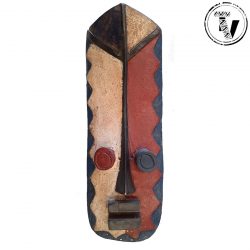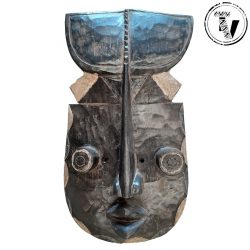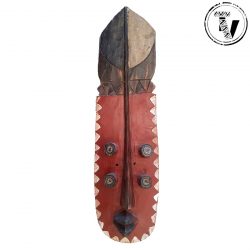Description
Bwa Hawk Mask 154cm
BWA (BOBO-OULE, BOBO-ULE, BWABA, BWAMU)
Burkina Faso and Mali
Numbering 125,000 in Mali and 175,000 in Burkina Faso, the Bwa are divided in three endogamous castes: farmers, blacksmiths, and griots (bards and musicians). The Bwa are farmers who grow grain, especially millet, sorghum and maize. They have grown very large amounts of cotton since the colonial period, and the cultivating of this cash crop has contributed to the destruction of their traditional patterns of cooperative farming. Agriculture is practiced primarily by the men, women participating on certain occasions only. The blacksmiths forge tools and cast brass, and their wives make pottery. The blacksmith is also the village’s gravedigger and is responsible for digging wells. He is thus the man in contact with the soil; this indicates his importance, his role as mediator in disputes and as intermediary with the supernatural world. The griots weave and dye cotton. They play an important social role and are essential in public events. The Bwa have no centralized political organization and every village is directed by a council of the eldest men of the lineages.
The spiritual life of the Bwa is based on worship devoted to Do and the founding ancestors of the clan. Do is at once an organization and an anthropomorphic being, the son of the creator god. Do represents the life-giving powers of nature, the forest and nourishing forces, sources of the life of plants and the fields, and intervenes at the time of agrarian rituals and funerals. Do is incarnated at initiations and village purifications, held just after crops are planted, by an otherworldly spirit masker whose “skin” is vines, grasses, and leaves. Deliberately non-human in shape, color, and behavior, the maskers celebrate life and help renew the forces of nature.
Wooden masks are found only among the Bwa in the south. The majority of masks have a circular face with geometric designs painted in vivid colors, and is surmounted by a large plank with a crescent-shaped motif at the end. The eyes set off by concentric circles, for instance, are intended to recall an owl, and the hooked shape extending from its forehead alludes to the hornbill. These masks represent animals: antelopes, warthogs, wild buffalo, monkeys, crocodiles, serpents, fish, birds, and insects, along with some human beings, and bush spirits who take on supernatural forms. The motifs are symbols linked to Do and to the history of the clan. The mask is worn in front of the face. They are differentiated only by the shape of the horns, while the muzzle and protruding eyes remain the same structure. The dancer looks through the open hole of the mouth. These masks are thought to be inhabited by supernatural forces, which act to benefit the clan that possess them. The Bwa carve also polychrome masks in horizontal shapes, which symbolize butterflies or hawks. The butterfly mask is decorated with concentric circles, while the hawk mask has a plain white surface. Masks are involved in burials, at the end of periods of mourning, in initiations, and for entertainment festivities on market days.
Bwa figures are relatively rare and are associated with divination ceremonies and human and agricultural fertility rites. They are paraded through villages and are offered sacrifices. The Bwa sculpt divination canes with curved ends; diviners use copper or brass bracelets decorated with standing figures that represent the spirits.






